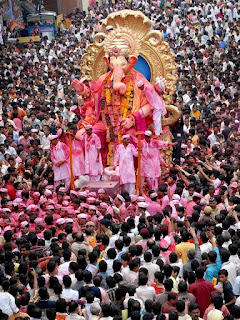#Bombayphile Lalbaugcha Raja : How Communal Tension Led To A Tradition
Maharashtra’s biggest
festival Ganeshutsav will come to an end this week. The highest crowd pulling
pandal of Mumbai through the last several decades has been that of Lalbaugcha Raja
in the mill district of the central Mumbai. Here is an excerpt from my book “Bombay
After Ayodhya” where I wrote about a tradition associated with the festival :
The tall fame of Lalbaug Ka
Raja extends till the last day of the festival when the 15 feet tall idol gets
pulled out of the pandal for immersion at Girgaon Chowpatty. Lakhs of people
participate in this 7-kilometre-long procession, which takes about twenty hours
because of the swarm of people throughout. The procession passes through some
of the most congested areas of South and Central Mumbai, including a few
communally sensitive patches. A large number of policemen are deployed when the
procession crosses the Muslim-dominated localities like Byculla, Nagpada and Do
Taki. In 1946, taking note of the communal riots that preceded the festival,
the Bombay Police ordered the route of the procession to be altered. However,
the organisers refused to obey and insisted on following the traditional route.
Ultimately, the immersion procession was taken out ten days later from the same
route. ‘The traditional route of the procession is sacrosanct as well because
sentiments of people are attached to it,’ said Sudhir Salvi, an office bearer
of the pandal.
The tradition of procession
continued even during some of the most sensitive times, such as the wars with
Pakistan during 1965 and 1971 and the horrifying Hindu-Muslim riots in Bhiwandi
during 1984. The year 1993 was perhaps the trickiest one. That year, the
Ganeshutsav was celebrated in the aftermath of the deadliest communal riots of
Bombay and a series of bomb blasts that shook the country. Sudhir Salvi
recollects, ‘The situation was very tense, and we were worried about the
consequences when the procession would pass from the Muslim-dominated areas.
Then a Muslim social worker named Jamdar Zariwala came to meet us with people
from his community. He said, “Whatever has happened has happened. We want to
welcome Lalbaug Ka Raja. When the procession reaches Nagpada junction, all
office bearers are invited on our stage. We will welcome you with Shahi Sherbet
(royal drink). Let the message of Hindu-Muslim unity go to the world from
Bombay.” From that year, it has become a tradition. Muslims welcome Lalbaug Ka
Raja and revellers are served Shahi Serbet. Jamdar chacha died few years ago
but his son has continued the tradition. The procession passes with no trouble
from the Muslim areas. En route to Chowpatty, Lalbaug Ka Raja is welcomed at
another location as well by the Muslim populace. When the procession reaches
Hindustani Masjid at Byculla, the Raja is garlanded and the Muslim residents
distribute sweets.
The procession of Lalbaug Ka
Raja is also one of the two religious events in Mumbai, where governmental
agencies also participate in an unusual way. When the procession crosses the
headquarters of the Mumbai Fire Brigade at Byculla, all the fire engines blare
their sirens simultaneously and switch on the beacons to “salute” the Lord. The
second tradition relates to the fifteenth century Sufi Saint Makhdoom Ali
Mahimi’s shrine at Mahim. During the annual urs or fair organised in December
every year, the policemen sing and dance in the procession and enjoy the first
right to pay their respects at the saint’s tomb. Makhdoom Ali Baba is famous as
‘the Saint of Police’ and it is believed that the policemen have been able to
solve several complicated cases with his blessings.
Coming back to the Lalbaug Ka
Raja, by the time his procession reaches Girgaon Chowpatty, it is 6 or 7 am of
the following day. Colourful boats of fishers surround the idol and extend
final salutations to the Lord. The idol is gently pulled into the deep waters
of the Arabian Sea and immersed.
(Bombayphile is published weekly where
Jitendra Dixit writes about the past and present of Mumbai.)


Comments